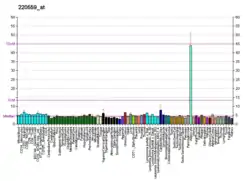EN1 (gene)
Homeobox protein engrailed-1 is a protein that in humans is encoded by the EN1 gene.[5][6]
Function
Homeobox-containing genes are thought to have a role in controlling development. In Drosophila, the engrailed (en) gene plays an important role during development in segmentation, where it is required for the formation of posterior compartments. Different mutations in the mouse homologs, En1 and En2, produced different developmental defects that frequently are lethal. The human engrailed homologs 1 and 2 encode homeodomain-containing proteins and have been implicated in the control of pattern formation during development of the central nervous system.[6]
Engrailed (En) 1 is a homeobox gene that helps primarily regulate development in the dorsal midbrain and anterior hindbrain (cerebellum and colliculi) of humans. The expression of En1 is regulated until 13 days after fertilization by Fgf8, which controls the development of the forebrain and hindbrain. En1 is first expressed in this region on day 9.5 after fertilization for about 12 hours until En2 is expressed. After En2 expression, En1 is expressed again in other tissues such as somites and limb ectoderm throughout development.[7] A knockout mouse model with the En1 homeobox deleted was developed; mice died less than 24 hours after birth because they refused to feed, although they had the physical ability. The brains of the mice were studied and most of the cerebellum, colliculi, and cranial nerves 3 and 4 were missing. There was clear deletion in the mid-hindbrain, isthmus, junction region that began at day 9.5 after fertilization. All of the mice demonstrated marked forepaw deformities including fusion of digits and sixth digits. The 13th ribs and sternums displayed delayed and abnormal ossification. The mouse model demonstrated that the expression of En1 is critical in the correct development of the brain, limbs, and sternum.[8]
References
- GRCh38: Ensembl release 89: ENSG00000163064 - Ensembl, May 2017
- GRCm38: Ensembl release 89: ENSMUSG00000058665 - Ensembl, May 2017
- "Human PubMed Reference:". National Center for Biotechnology Information, U.S. National Library of Medicine.
- "Mouse PubMed Reference:". National Center for Biotechnology Information, U.S. National Library of Medicine.
- Kohler A, Logan C, Joyner AL, Muenke M (Mar 1993). "Regional assignment of the human homeobox-containing gene EN1 to chromosome 2q13-q21". Genomics. 15 (1): 233–235. doi:10.1006/geno.1993.1045. PMID 8094370.
- "Entrez Gene: EN1 engrailed homeobox 1".
- Sgaier SK, Lao Z, Villanueva MP, Berenshteyn F, Stephen D, Turnbull RK, Joyner AL (June 2007). "Genetic subdivision of the tectum and cerebellum into functionally related regions based on differential sensitivity to engrailed proteins". Development. 134 (12): 2325–35. doi:10.1242/dev.000620. PMC 2840613. PMID 17537797.
- Wurst W, Auerbach AB, Joyner AL (July 1994). "Multiple developmental defects in Engrailed-1 mutant mice: an early mid-hindbrain deletion and patterning defects in forelimbs and sternum". Development. 120 (7): 2065–75. PMID 7925010.
Further reading
- Logan C, Hanks MC, Noble-Topham S, et al. (1993). "Cloning and sequence comparison of the mouse, human, and chicken engrailed genes reveal potential functional domains and regulatory regions". Dev. Genet. 13 (5): 345–358. doi:10.1002/dvg.1020130505. PMID 1363401.
- Logan C, Willard HF, Rommens JM, Joyner AL (1989). "Chromosomal localization of the human homeo box-containing genes, EN1 and EN2". Genomics. 4 (2): 206–209. doi:10.1016/0888-7543(89)90301-7. PMID 2567700.
- Kozmik Z, Sure U, Rüedi D, et al. (1995). "Deregulated expression of PAX5 in medulloblastoma". Proc. Natl. Acad. Sci. U.S.A. 92 (12): 5709–5713. Bibcode:1995PNAS...92.5709K. doi:10.1073/pnas.92.12.5709. PMC 41766. PMID 7777574.
- Loomis CA, Harris E, Michaud J, et al. (1996). "The mouse Engrailed-1 gene and ventral limb patterning". Nature. 382 (6589): 360–363. Bibcode:1996Natur.382..360L. doi:10.1038/382360a0. PMID 8684466. S2CID 4326299.
- Joliot A, Trembleau A, Raposo G, et al. (1997). "Association of Engrailed homeoproteins with vesicles presenting caveolae-like properties". Development. 124 (10): 1865–75. PMID 9169834.
- Mikkola I, Bruun JA, Holm T, Johansen T (2001). "Superactivation of Pax6-mediated transactivation from paired domain-binding sites by dna-independent recruitment of different homeodomain proteins". J. Biol. Chem. 276 (6): 4109–4118. doi:10.1074/jbc.M008882200. PMID 11069920.
- Hartley JL, Temple GF, Brasch MA (2001). "DNA cloning using in vitro site-specific recombination". Genome Res. 10 (11): 1788–1795. doi:10.1101/gr.143000. PMC 310948. PMID 11076863.
- Schaefer LK, Wang S, Schaefer TS (2001). "Functional interaction of Jun and homeodomain proteins". J. Biol. Chem. 276 (46): 43074–43082. doi:10.1074/jbc.M102552200. PMID 11551904.
- Strausberg RL, Feingold EA, Grouse LH, et al. (2003). "Generation and initial analysis of more than 15,000 full-length human and mouse cDNA sequences". Proc. Natl. Acad. Sci. U.S.A. 99 (26): 16899–16903. doi:10.1073/pnas.242603899. PMC 139241. PMID 12477932.
- Hori Y, Gu X, Xie X, Kim SK (2006). "Differentiation of insulin-producing cells from human neural progenitor cells". PLOS Med. 2 (4): e103. doi:10.1371/journal.pmed.0020103. PMC 1087208. PMID 15839736.
- Bachar-Dahan L, Goltzmann J, Yaniv A, Gazit A (2006). "Engrailed-1 negatively regulates beta-catenin transcriptional activity by destabilizing beta-catenin via a glycogen synthase kinase-3beta-independent pathway". Mol. Biol. Cell. 17 (6): 2572–2580. doi:10.1091/mbc.E06-01-0052. PMC 1474795. PMID 16571670.
- Atit R, Sgaier SK, Mohamed OA, et al. (2006). "Beta-catenin activation is necessary and sufficient to specify the dorsal dermal fate in the mouse". Dev. Biol. 296 (1): 164–176. doi:10.1016/j.ydbio.2006.04.449. PMID 16730693.
External links
- EN1+protein,+human at the US National Library of Medicine Medical Subject Headings (MeSH)
This article incorporates text from the United States National Library of Medicine, which is in the public domain.




